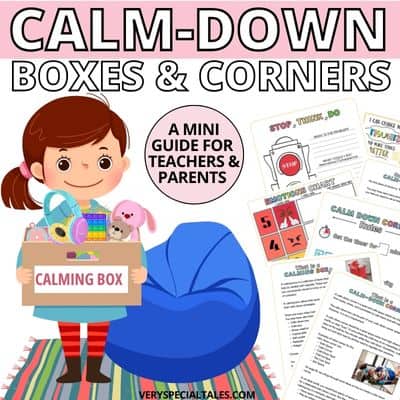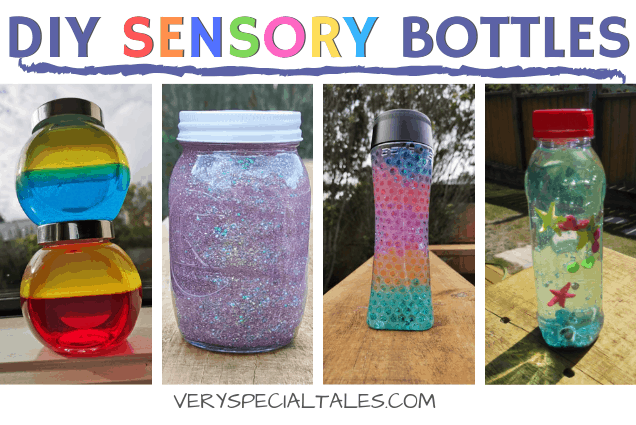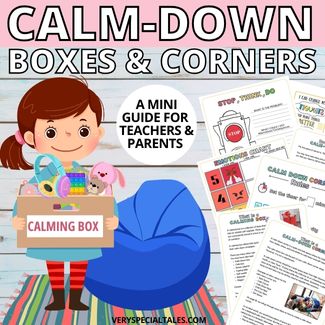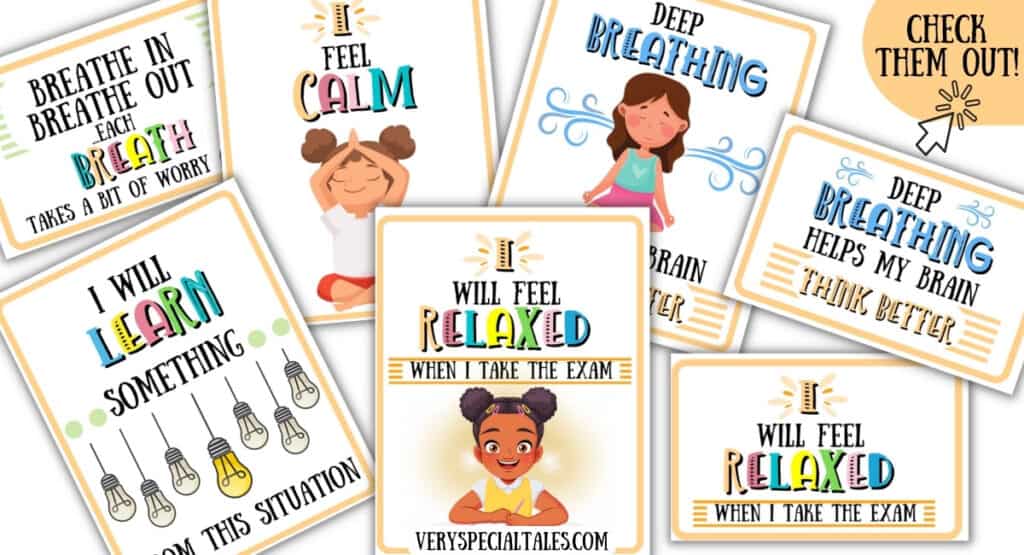
How to Prepare a Calming Box for your Kids or Students
Looking for ideas for a calming box for home or the classroom?
Preparing a calming box is easy and a very practical strategy that will facilitate kids’ self-soothing.
There are lots of activities that can help our kids when they are feeling upset, angry, anxious or overexcited.
But when kids need to put their coping skills to good use, it can be very impractical to start looking around the house for those toys, books or tools that help them calm down.
If you are a teacher, a calming kit is also a great addition to your calm down corner in the classroom (and this Calm-Down Box /Corner Guide could also be a great help).

(Disclosure: We are a participant in the Amazon Services LLC Associates Program, an affiliate advertising program designed to provide a means for us to earn fees by linking to Amazon.com and affiliated sites. There may also be other affiliate links in this post. You can also read our Disclosure & Disclaimer policy here)
What is a calming box?
A calming box is a collection of items that help us self-regulate that are conveniently stored in a box or other type of container.
Having a calm down kit toolbox allows you to easily access all the items that facilitate your kids’ calm down strategies.
You may have also heard them referred as a calm down box, a calm box, a stress relief kit, or a coping skills toolbox.
Some people use the term “sensory box,” but not all items in your toolbox are meant to provide sensory inputs.
Self-soothe boxes can be beneficial for people of any age, including children, teenagers, and adults.
If you want to explore this topic more in-depth, you can also grab our Calming Box / Calm-Down Corner Guide (printable resource).
When should I use the calming box?
There are many situations at home and school when your kids or students will benefit from using self-soothing boxes:
- When feeling overwhelmed
- In times of distress
- During moments of anger or frustration
- When experiencing feelings of anxiety
- During their bedtime routine
- When kids need a sensory break
What do you put in a calm-down box?
The short answer is anything that works for your kid.
You know your kid’s needs better than anybody else but, just in case you need some inspiration, I will share some ideas from our own calm down box.
I will also add some items that we aren’t using but that are also popular self-soothing tools.
In order to prepare your calm box, grab any nice box that you have around (it doesn’t need to be anything fancy).
Make sure it is big enough to fit all the self-regulation items that your child may use (sensory toys, books and worksheets, and some of their favorite things.)
Items that you may consider including in your coping skills toolbox:
1. Calm Down Strategy Cards.
Visual cues can be an effective help when your kid is choosing calming strategies.
We have printed ours in two different formats: a booklet where we can see different strategies at glance, and cards that we can carry around in a pocket, a backpack or on a lanyard.
(Link for downloads at the end of the post)

2. Books
Books can distract your child from the feeling he/she is experiencing.
Any book may do the trick, but I like to include books that deal with the issues my child may be experiencing (anger, anxiety, confusion).
These are some of our favorite titles:
👉 What to Do When Your Temper Flares. A Kids Guide to Overcoming Problems With Anger
👉 Everybody Feels Angry!
👉 Wilma Jean the Worry Machine
👉 The Anxiety Workbook for Kids
3. Sensory Bottles / Calming Jars
A sensory bottle is a very useful calming tool.
A Sensory Bottle is a bottle or jar container usually filled with a liquid solution where different materials can float and flow, creating a visually soothing and pleasant experience for the child’s senses.
Check out our post on homemade sensory bottles with four easy recipes that you prepare with ingredients you probably already have in your pantry.

4. Favorite soft toys
Hugging a favorite soft toy can also help self-regulate.
You can also teach them how to “breathe in/hug tight / breathe out-relax”, repeating this cycle several times till they start feeling calmer
5. Fidgeting toys
Some kids just love fidgeting with little toys. It is another way of taking their minds from those feelings that have been bothering them.
Some research has shown that kids with attention deficit hyperactivity disorder (ADHD) may find fidgeting beneficial, as physical movement may help concentration and focus.
So make sure you add a fidget spinner, fidget cubes, sensory rings, or any other type of fidgeting toy.
Related reading: How to Use Fidget Toys Effectively in the Classroom
6. Problem-solving worksheets
If those strong emotions have been caused by problems that can be solved, a little extra help from a problem-solving worksheet may go a long way.
These are the ones we use:

7. Stress balls
Stress Balls are hand-sized ductile balls used as manipulative and/or therapy objects.
Squeezing and releasing the ball in your hand helps relieve tension and strengthens the muscles.
Stress balls are also a very popular DIY / craft activity.
Homemade stress balls may be filled with flour, water beads, rice, play dough, dry beans, or lentils, just to mention some examples.
8. Music
You know the saying that music soothes the savage beast.
Nothing like relaxing music to make the tension go.
You can have a 30 day FREE trial of Amazon Music Unlimited here? FREE TRIAL
9. Noise-canceling headphones
Loud noises in the classroom can disrupt concentration and, for some kids, they may be stressful, impacting their learning experience.
10. Positive affirmations cards
Positive affirmations are positive statements that we tell ourselves for self-motivation or to challenge negative thoughts.
Learn all you need to know about positive affirmations and how to practice affirmations ?
Check out the following articles:
11. Emotions Charts
An emotions chart is a visual resource that features emoticons, pictures or face drawings describing different emotions. It is a useful ally when kids have difficulties labeling or expressing their feelings.
👉 Learn about emotions charts for kids (includes a free emotion chart download)
👉 Keep track of your child’s feelings with a mood tracker
12. A journal
Some kids may find it easier to express their feelings in a feelings journal.
We have developed two gorgeous journals to help kids understand and navigate their feelings:
1. The Cool Kid Journal is our most comprehensive resource for anger management and coping skills development for kids.
2. The Confidence journal is absolutely gorgeous and it helps kids discover:
-
- how to believe in themselves
- how to face challenges with confidence
- that mistakes help us learn
13. A drawing notebook
Other kids may find it difficult to find the words to express their feelings but may be able to draw their emotions on paper
14. A worry eater
We have the cutie you see in the picture below, and often write our problems on a piece of paper and let the worry eater take care of them.

15. Happy thoughts scrapbook
Add a scrapbook with all the happy memories and favorite places, to help change bad thoughts into happy ones
16. A laminated print-out of your kid’s favorite jokes
17. Breathing exercises enablers, like a bottle of bubbles or deep breathing worksheets.
Deep breathing is one of the best relaxation techniques.
Taking deep breaths can be a valuable tool for managing symptoms of panic, anger, or other emotional distress.
18. Thinking putty / Silly putty
Stretch it, twist it and relax!
19. A bag of cookies
Nothing that favorite cookies can’t fix.
Ok, it may also be a healthy snack ?
20. A weighted blanket
Many kids find the pressure of a weighted blanket very comforting.
Check out these tips on how to use your weighted blanket (and learn from my mistakes!)
21. A weighted stuffed puppy
This soft plus doggy has been designed for kids sensory processing disorders. It allows them to be calm down, remain seated for longer periods of time, improve sleep, relieve stress, and it creates a great grounding effect.
And it is really cute!
There are no age limits to “Calm-Down Boxes.”
But, it is important to customize the box to the individual needs of the person using it. Younger kids’ preferences may differ from those of older kids.
For adults, you may consider adding essential oils or scented candles.
Don’t forget to check our Calming Box / Calm-Down Corner Guide to learn how to implement this helpful calm-down tool.⇓
 Ideas for a Calm-Down Corner
Ideas for a Calm-Down Corner
If you have enough space, you could go the extra mile and create a calm-down corner.
A calm-down corner is a quiet area where the child can withdraw from noises, stress, and overwhelm to calm down and self-regulate.
Your calm-down corner could also include bigger items like a bean bag, a bouncing ball (these are really cute), an indoor swing or an enclosed space (like this teepee tent) where your child could regain equilibrium.
Other Calming Ideas for Kids
Ready to start preparing your calming box?
If you wish to download our Calm Down Cards you will find the link in the following post:
How to Prepare a Calming Box for your Kids or Students
Pin this? in your Parenting board to check it out as often as you need ♥






One Comment
lalitha
I found website very interesting, So much to learn and to try out. Thank you
lalitha